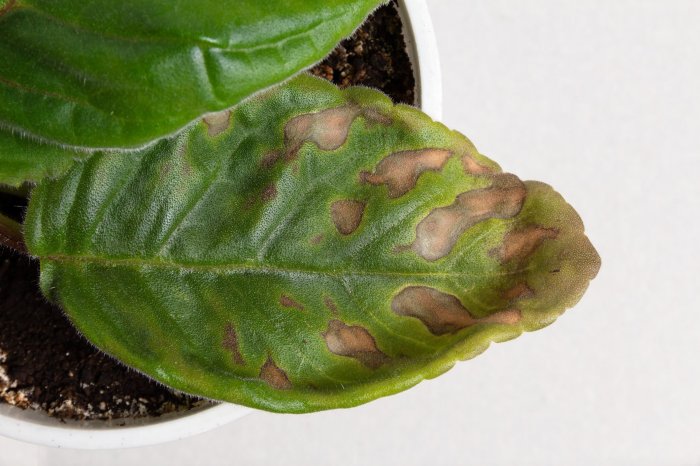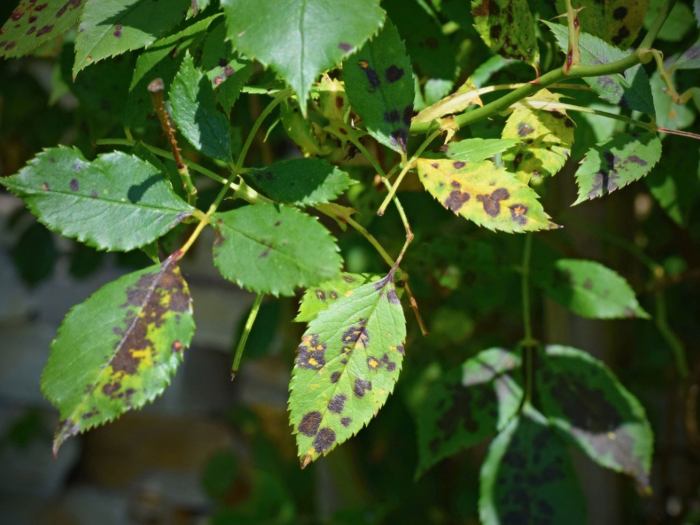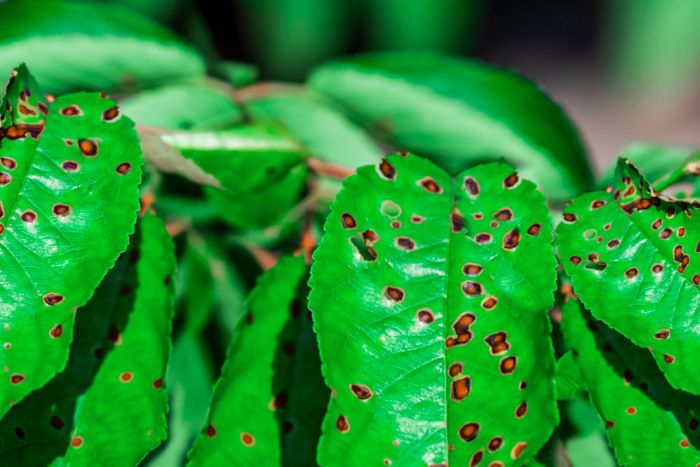How to treat brown spots on plants – Brown spots on plants can be a frustrating sight, but understanding their causes and implementing effective treatments can restore your plants to their vibrant health. This comprehensive guide will delve into the various factors behind brown spots, provide a step-by-step identification process, and offer proven cultural practices, chemical control options, and natural remedies to combat this common plant problem.
Common Causes of Brown Spots on Plants

Brown spots on plants can be a sign of various underlying issues, ranging from infections to environmental stresses. Understanding the cause is crucial for effective treatment and prevention.
Fungal Infections
Fungal infections are a common cause of brown spots on plants. Symptoms may include circular or irregular spots that start small and gradually enlarge, often with a yellow or brown halo around them. The spots may also have a velvety or powdery texture.
Common fungal diseases that cause brown spots include leaf spot, powdery mildew, and rust.
Brown spots on plants can indicate a variety of issues, from nutrient deficiencies to fungal infections. To effectively treat these spots, it’s crucial to identify the underlying cause. For instance, if the spots are caused by a lack of sunlight, consider hanging plants in a brighter location.
Alternatively, if the spots are due to a fungal infection, apply a fungicide specifically designed for plants.
Bacterial Diseases
Bacterial diseases can also cause brown spots on plants. Symptoms may include water-soaked spots that turn brown and develop a yellow or orange halo. The spots may also be surrounded by a sticky or slimy substance. Common bacterial diseases that cause brown spots include bacterial leaf spot and blight.
Insect Infestations
Insects can cause brown spots on plants by feeding on the leaves or stems. Symptoms may include small, round spots or irregular patches that are brown or black in color. The spots may also be accompanied by other signs of insect damage, such as holes in the leaves or webbing.
Common insects that cause brown spots include aphids, thrips, and spider mites.
Nutrient Deficiencies
Nutrient deficiencies can also cause brown spots on plants. Symptoms may include brown or yellow spots that start at the tips or edges of the leaves and gradually spread inward. The spots may also be accompanied by other symptoms of nutrient deficiency, such as stunted growth or yellowing leaves.
Common nutrient deficiencies that cause brown spots include nitrogen deficiency, potassium deficiency, and magnesium deficiency.
Environmental Stresses
Environmental stresses, such as drought, heat, or cold, can also cause brown spots on plants. Symptoms may include brown or yellow spots that appear on the leaves or stems. The spots may also be accompanied by other symptoms of environmental stress, such as wilting or leaf drop.
Identifying the Type of Brown Spot
Accurately identifying the type of brown spot affecting a plant is crucial for determining the appropriate treatment. A thorough examination of the plant, its symptoms, and diagnostic tools can help identify the specific cause of the brown spots.
To identify the type of brown spot, follow these steps:
- Examine the plant:Observe the location, size, shape, and color of the brown spots. Note any patterns or other symptoms, such as wilting, yellowing, or leaf drop.
- Use diagnostic tools:Utilize a magnifying glass or hand lens to examine the brown spots closely. Look for signs of insects, fungal spores, or other organisms.
- Consult with experts:Seek advice from plant experts, such as horticulturists or arborists, who can help identify the brown spots based on their experience and knowledge.
- Use online identification tools:Utilize online resources and databases that provide images and descriptions of various plant diseases and their symptoms.
- Refer to plant disease reference materials:Consult books, articles, or websites that provide detailed information on plant diseases, including descriptions of brown spots and their causes.
Correctly identifying the type of brown spot allows for targeted treatment, preventing further damage to the plant and ensuring its health.
Cultural Practices for Brown Spot Prevention

Implementing appropriate cultural practices can significantly reduce the risk of brown spot development on plants. These practices focus on optimizing growing conditions, enhancing plant health, and minimizing the presence of pathogens.
Proper watering techniques are crucial for preventing brown spots. Overwatering can create an environment conducive to fungal growth, while underwatering can weaken plants and make them more susceptible to disease. Watering deeply and infrequently allows the soil to dry out between watering, reducing the likelihood of waterlogging and fungal proliferation.
Appropriate Fertilization
Balanced fertilization is essential for plant health and disease resistance. Avoid over-fertilizing, as excess nitrogen can stimulate excessive growth and make plants more vulnerable to brown spots. Use a balanced fertilizer that provides essential nutrients without promoting rapid, succulent growth.
Good Air Circulation
Good air circulation helps prevent moisture buildup and reduces the risk of fungal infections. Space plants adequately to allow for proper air flow. Avoid overcrowding, especially in humid environments.
Crop Rotation
Crop rotation is a valuable practice for preventing brown spot development. Rotating crops to different locations each season helps break disease cycles and reduce the buildup of pathogens in the soil.
Companion Planting
Companion planting involves growing certain plant species together to create a mutually beneficial environment. Some companion plants can help repel insects or inhibit the growth of pathogens that cause brown spots.
Sanitation
Maintaining good sanitation in the garden is crucial for preventing brown spot development. Remove and destroy infected plant material promptly to prevent the spread of disease. Regularly clean garden tools and equipment to avoid cross-contamination.
Chemical and Biological Control Options
To combat brown spots on plants, chemical and biological control measures can be implemented. These methods aim to eliminate or suppress the pathogens causing the discoloration.
Chemical control involves the use of fungicides and bactericides, which are substances that kill or inhibit the growth of fungi and bacteria, respectively. These chemicals can be applied to the affected plant parts through spraying, drenching, or injecting.
Chemical Fungicides and Bactericides
| Type | Mode of Action | Application Method | Potential Risks |
|---|---|---|---|
| Contact fungicides | Form a protective layer on plant surfaces, preventing pathogen entry | Spraying | May harm beneficial insects and microorganisms |
| Systemic fungicides | Absorbed by the plant and distributed throughout its tissues, providing long-term protection | Drenching, injection | Can accumulate in plant tissues and pose environmental risks |
| Bactericides | Inhibit bacterial growth and reproduction | Spraying, drenching | Can lead to antibiotic resistance in bacteria |
Biological control, on the other hand, utilizes natural enemies of plant pathogens, such as beneficial insects, microorganisms, and plant extracts. These agents can be introduced to the environment to suppress or eliminate the pathogens.
Treating brown spots on plants requires prompt attention to prevent further damage. For effective care, consider repotting into Bunnings Outdoor Ceramic Pots . These stylish and durable pots provide optimal drainage, ensuring healthy root growth. After repotting, apply a fungicide to combat fungal infections that may cause brown spots.
Biological Control Agents
- Beneficial insects:Ladybugs, lacewings, and parasitic wasps feed on aphids, mealybugs, and other insects that transmit plant diseases.
- Microorganisms:Bacteria and fungi can produce antibiotics or compete with pathogens for nutrients, inhibiting their growth.
- Plant extracts:Neem oil, garlic extract, and tea tree oil have antifungal and antibacterial properties.
Biological control methods are often considered more environmentally friendly than chemical control, as they minimize the use of synthetic chemicals and promote biodiversity.
Home Remedies and Natural Treatments

Treating brown spots on plants can be effectively achieved using home remedies and natural treatments. These methods offer organic solutions, reducing reliance on chemical pesticides and fertilizers. Understanding the mechanisms of action and proper application is crucial for successful results.
Baking Soda Solution
Baking soda possesses antifungal and antibacterial properties, making it an effective remedy for brown spots caused by fungal infections. To prepare a baking soda solution, dissolve 1 tablespoon of baking soda in 1 gallon of water. Apply the solution directly to the affected areas using a spray bottle.
Treating brown spots on plants requires a tailored approach depending on the underlying cause. For instance, if the spots are caused by fungal diseases, fungicides may be necessary. Alternatively, if nutrient deficiencies are to blame, Bunnings Orchid Soil: The Ultimate Guide to Nurturing Your Orchids provides valuable insights into soil selection and nutrient optimization, which can help prevent brown spots in the first place.
By addressing the root cause of the discoloration, plant owners can effectively restore their plants’ health and vitality.
Repeat the application every 7-10 days until the spots disappear.
Neem Oil Applications
Neem oil is extracted from the neem tree and contains insecticidal and fungicidal compounds. It effectively controls various pests and diseases that cause brown spots. To use neem oil, mix 2 teaspoons of neem oil with 1 gallon of water and add a few drops of dish soap as an emulsifier.
Spray the solution on the affected plants, ensuring thorough coverage of the foliage. Reapply every 10-14 days for optimal results.
Garlic Sprays, How to treat brown spots on plants
Garlic possesses antimicrobial properties and can be used to treat brown spots caused by bacterial or fungal infections. To make a garlic spray, crush 1-2 cloves of garlic and mix them with 1 gallon of water. Let the mixture sit overnight before straining it.
If you notice brown spots appearing on your plants, it’s crucial to address them promptly. Treating these spots can help prevent the spread of disease and restore the health of your greenery. One effective solution is to consult the comprehensive guide available at Discover the Enchanting World of Bunnings Plant Baskets: A Guide to Types Uses and Care . This resource offers valuable insights into the causes and treatments of brown spots on plants, ensuring you can maintain a thriving indoor garden.
Apply the spray to the affected plants, focusing on the areas with brown spots. Repeat the application every 7-10 days until the spots diminish.
Limitations and Considerations
While home remedies and natural treatments can be effective, they may have limitations. Severe infestations or infections may require stronger chemical treatments. Additionally, some natural remedies may cause phytotoxicity (plant damage) if not used correctly. It is advisable to test the solutions on a small area of the plant before applying them to the entire plant.
Outcome Summary: How To Treat Brown Spots On Plants

Whether you’re a seasoned gardener or a novice plant enthusiast, this guide has equipped you with the knowledge and tools to effectively address brown spots on your plants. Remember, prevention is key, but when spots arise, prompt action and appropriate treatments can restore your plants to their former glory.
Top FAQs
What are the most common causes of brown spots on plants?
Brown spots can be caused by various factors, including fungal infections, bacterial diseases, insect infestations, nutrient deficiencies, and environmental stresses.
How can I identify the type of brown spot affecting my plant?
Examine the plant’s symptoms, such as the appearance, location, and progression of the brown spots. Consult plant experts, use online identification tools, or refer to plant disease reference materials for accurate diagnosis.
What cultural practices can help prevent brown spots on plants?
Proper watering techniques, appropriate fertilization, maintaining good air circulation, crop rotation, companion planting, and sanitation can help reduce the risk of brown spot development.
What chemical control options are available for brown spots?
Chemical fungicides and bactericides can be used to treat brown spots. Consult a plant expert or refer to product labels for specific recommendations and application instructions.
Are there any effective home remedies or natural treatments for brown spots?
Home remedies such as baking soda solutions, neem oil applications, and garlic sprays can be effective in treating brown spots. However, always test natural treatments on a small area first and follow application instructions carefully.